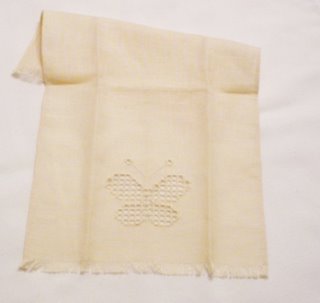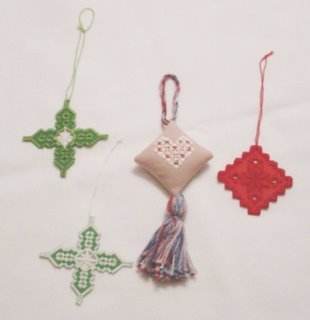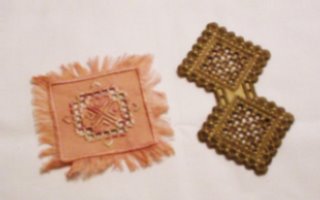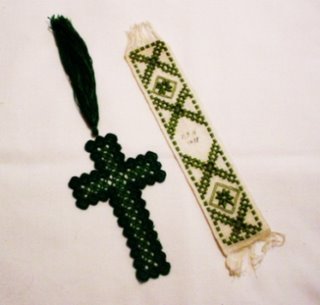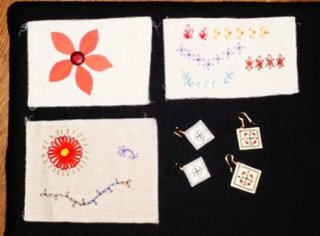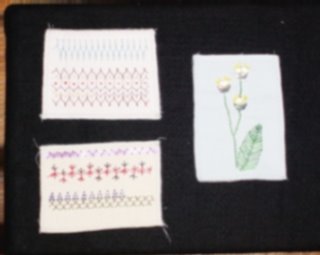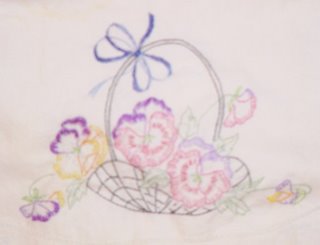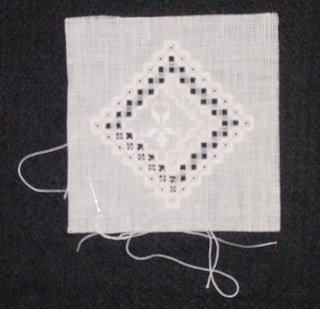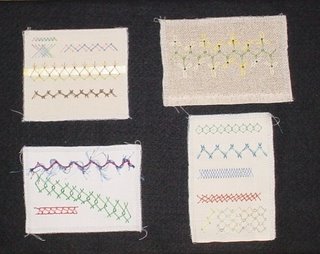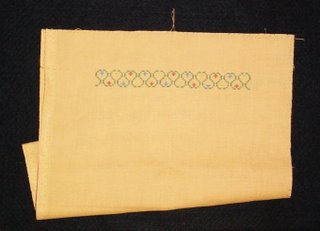Brrr....... baby it's cold outside
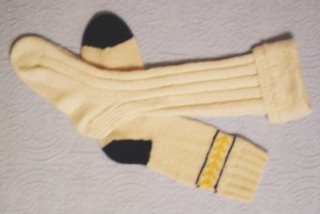 That's kinda what happens in the winter time isn't it???? Yesterday was very, very cold. Up until 9am the wind chill factor was 10-15 degrees below 0 F. and the warmest it got was 19 degrees. So very warm hand knit wool socks were in order. So I thought I'd share some of my hand knit socks (I'm not showing the whole pair, just one is all that's necessary to get the idea).
That's kinda what happens in the winter time isn't it???? Yesterday was very, very cold. Up until 9am the wind chill factor was 10-15 degrees below 0 F. and the warmest it got was 19 degrees. So very warm hand knit wool socks were in order. So I thought I'd share some of my hand knit socks (I'm not showing the whole pair, just one is all that's necessary to get the idea).The solid knee sock in the first photo has a special meaning. Back in 1990 I took my first major excursion into another part of the world. Being a family researcher I joined the ROSE Family Association (my paternal grandmother was a Rose) and this group took a tour to Scotland to visit the Rose family castle (we also went to Wales, Ireland and England). While in Scotland I of course sought out yarn shops to purchase pure Scottish wool. Would you believe they could not be found where our group went......... until at the very last stop just miles before crossing the border from Scotland to England there was a small yarn shop. You know how you look for special significant souvenirs to bring home.......... I wanted a pair of handknit traditional kilt hose. Whoohoo...... the price was 60pounds per pair. That's when I started looking for the yarn shops tee hee In the shop that was pointed out to me by the tour guide I found the 100% wool yarn for my stockings AND the pattern.......... so I had to knit them.......... I love knitting socks. Of course that wasn't all the yarn I bought (VBG) The other sock in the pic when worn comes to just below the knee and also is made of 100% wool.
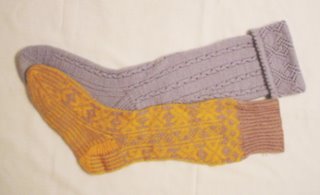 Any sock knitters out there in cyberspace know the name Elizabeth Zimmerman, born in England, married a German, came to America, etc. In one of her books she tells of knitting ski hose for her husband.... that's the patterned sock on top and I choose bright orange and a soft brown to experiment with and boy, not only do they fit well, but are very warm and comfortable. The bottom sock is also a traditional kilt hose pattern and is knitted of a beautiful greyish brown wool. So far all the socks I've shown you were knitted of sports weight yarn. For non-knitters that is a medium weight yarn.
Any sock knitters out there in cyberspace know the name Elizabeth Zimmerman, born in England, married a German, came to America, etc. In one of her books she tells of knitting ski hose for her husband.... that's the patterned sock on top and I choose bright orange and a soft brown to experiment with and boy, not only do they fit well, but are very warm and comfortable. The bottom sock is also a traditional kilt hose pattern and is knitted of a beautiful greyish brown wool. So far all the socks I've shown you were knitted of sports weight yarn. For non-knitters that is a medium weight yarn.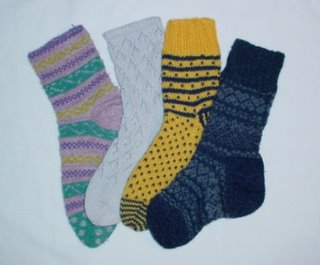 Now for some fun socks!!!! If I could wear clogs or similar type shoes I could really show off my socks. From left to right I have one of the most fun pair to knit - really they were. All the different patterns and colors oh my! Well, I have to tell you that this sock is patterned all the way around but on its mate the sole was knitted in stripes and not patterns.......... you see one is for the right foot and the other for the left tee hee The second sock is one of that is knitted in a fingering (or baby) weight yarn and is knitted of 100% cotton......... yes it is a wear in spring and summer sock. Oh, I still wear commercial socks because I haven't had time to knit all the socks I want to wear........ but I have lots of sock yarn to use! With the cold temp. of yesterday I had on one of my favorite pairs - the bright yellow and navy blue that you see above. The last one I'm showing is done in a tweed and so the little flecks don't show up but it is also knit of fingering yarn. I haven't shown any of my worsted weight socks - they are the ones that cause me to wear a shoe one size larger than normal in order to accomodate the thickness.
Now for some fun socks!!!! If I could wear clogs or similar type shoes I could really show off my socks. From left to right I have one of the most fun pair to knit - really they were. All the different patterns and colors oh my! Well, I have to tell you that this sock is patterned all the way around but on its mate the sole was knitted in stripes and not patterns.......... you see one is for the right foot and the other for the left tee hee The second sock is one of that is knitted in a fingering (or baby) weight yarn and is knitted of 100% cotton......... yes it is a wear in spring and summer sock. Oh, I still wear commercial socks because I haven't had time to knit all the socks I want to wear........ but I have lots of sock yarn to use! With the cold temp. of yesterday I had on one of my favorite pairs - the bright yellow and navy blue that you see above. The last one I'm showing is done in a tweed and so the little flecks don't show up but it is also knit of fingering yarn. I haven't shown any of my worsted weight socks - they are the ones that cause me to wear a shoe one size larger than normal in order to accomodate the thickness.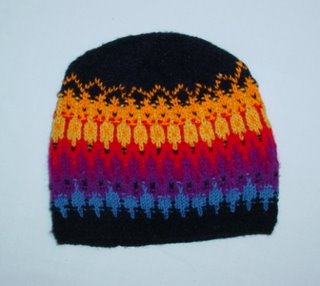 NOPE! Not socks....... but I just had to share this cap. It is done in Bohus knitting - a Swedish technique that was developed in the early 1940's. It is knit entirely of 100% needlepoint wool and is very lightweight. It looks complicated but is made up of knit, purl, and slipped stitches and is easy enough for an advanced beginner to knit. Doesn't the patterning remind you of embroidery stitches? I just had to throw that in for my embroidery friends all around the world.
NOPE! Not socks....... but I just had to share this cap. It is done in Bohus knitting - a Swedish technique that was developed in the early 1940's. It is knit entirely of 100% needlepoint wool and is very lightweight. It looks complicated but is made up of knit, purl, and slipped stitches and is easy enough for an advanced beginner to knit. Doesn't the patterning remind you of embroidery stitches? I just had to throw that in for my embroidery friends all around the world.


